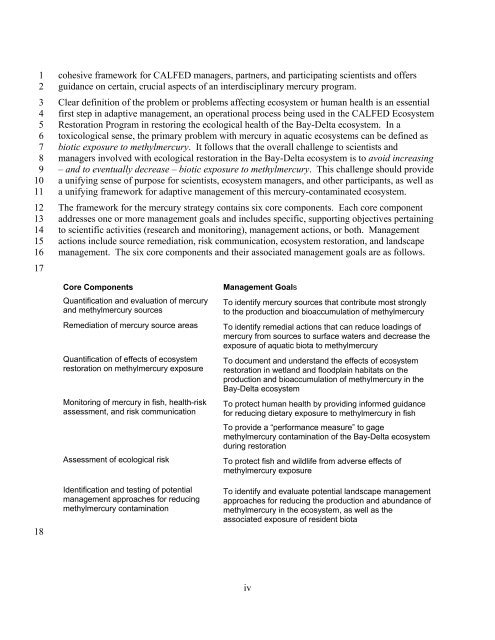Mercury Strategy for the Bay-Delta Ecosystem - CALFED Bay-Delta ...
Mercury Strategy for the Bay-Delta Ecosystem - CALFED Bay-Delta ...
Mercury Strategy for the Bay-Delta Ecosystem - CALFED Bay-Delta ...
Create successful ePaper yourself
Turn your PDF publications into a flip-book with our unique Google optimized e-Paper software.
1<br />
2<br />
3<br />
4<br />
5<br />
6<br />
7<br />
8<br />
9<br />
10<br />
11<br />
12<br />
13<br />
14<br />
15<br />
16<br />
17<br />
18<br />
cohesive framework <strong>for</strong> <strong>CALFED</strong> managers, partners, and participating scientists and offers<br />
guidance on certain, crucial aspects of an interdisciplinary mercury program.<br />
Clear definition of <strong>the</strong> problem or problems affecting ecosystem or human health is an essential<br />
first step in adaptive management, an operational process being used in <strong>the</strong> <strong>CALFED</strong> <strong>Ecosystem</strong><br />
Restoration Program in restoring <strong>the</strong> ecological health of <strong>the</strong> <strong>Bay</strong>-<strong>Delta</strong> ecosystem. In a<br />
toxicological sense, <strong>the</strong> primary problem with mercury in aquatic ecosystems can be defined as<br />
biotic exposure to methylmercury. It follows that <strong>the</strong> overall challenge to scientists and<br />
managers involved with ecological restoration in <strong>the</strong> <strong>Bay</strong>-<strong>Delta</strong> ecosystem is to avoid increasing<br />
– and to eventually decrease – biotic exposure to methylmercury. This challenge should provide<br />
a unifying sense of purpose <strong>for</strong> scientists, ecosystem managers, and o<strong>the</strong>r participants, as well as<br />
a unifying framework <strong>for</strong> adaptive management of this mercury-contaminated ecosystem.<br />
The framework <strong>for</strong> <strong>the</strong> mercury strategy contains six core components. Each core component<br />
addresses one or more management goals and includes specific, supporting objectives pertaining<br />
to scientific activities (research and monitoring), management actions, or both. Management<br />
actions include source remediation, risk communication, ecosystem restoration, and landscape<br />
management. The six core components and <strong>the</strong>ir associated management goals are as follows.<br />
Core Components Management Goals<br />
Quantification and evaluation of mercury<br />
and methylmercury sources<br />
To identify mercury sources that contribute most strongly<br />
to <strong>the</strong> production and bioaccumulation of methylmercury<br />
Remediation of mercury source areas To identify remedial actions that can reduce loadings of<br />
mercury from sources to surface waters and decrease <strong>the</strong><br />
exposure of aquatic biota to methylmercury<br />
Quantification of effects of ecosystem<br />
restoration on methylmercury exposure<br />
Monitoring of mercury in fish, health-risk<br />
assessment, and risk communication<br />
To document and understand <strong>the</strong> effects of ecosystem<br />
restoration in wetland and floodplain habitats on <strong>the</strong><br />
production and bioaccumulation of methylmercury in <strong>the</strong><br />
<strong>Bay</strong>-<strong>Delta</strong> ecosystem<br />
To protect human health by providing in<strong>for</strong>med guidance<br />
<strong>for</strong> reducing dietary exposure to methylmercury in fish<br />
To provide a “per<strong>for</strong>mance measure” to gage<br />
methylmercury contamination of <strong>the</strong> <strong>Bay</strong>-<strong>Delta</strong> ecosystem<br />
during restoration<br />
Assessment of ecological risk To protect fish and wildlife from adverse effects of<br />
methylmercury exposure<br />
Identification and testing of potential<br />
management approaches <strong>for</strong> reducing<br />
methylmercury contamination<br />
To identify and evaluate potential landscape management<br />
approaches <strong>for</strong> reducing <strong>the</strong> production and abundance of<br />
methylmercury in <strong>the</strong> ecosystem, as well as <strong>the</strong><br />
associated exposure of resident biota<br />
iv

















